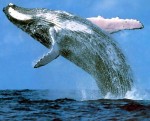 The ocean, for most, represents a great blue void. It is sometimes hard to imagine that an incredible world, much larger than the space terrestrial beings inhabit, lies beyond the shoreline and below the surface. The Censes of Marine Life, completed in 2010 by 2,700 scientists from 80 countries, identified more than 1 million species that call the ocean home. In addition, researchers feel that despite their great accomplishment, 50-80% of the species inhabiting the sea surrounding South Africa, Antarctica, Japan, the Mediterranean, and Australia are yet to be discovered. The ocean covers 71% of Earth’s surface and holds 97% of Earth’s water; yet more than 95% of it remain unexplored. Regardless of where we live, the ocean is directly connected to each and every one of us. As a regulator of our environment, as an inspiring muse and representation of paradise, or as a place to find nourishment, the ocean breathes life into us all.
The ocean, for most, represents a great blue void. It is sometimes hard to imagine that an incredible world, much larger than the space terrestrial beings inhabit, lies beyond the shoreline and below the surface. The Censes of Marine Life, completed in 2010 by 2,700 scientists from 80 countries, identified more than 1 million species that call the ocean home. In addition, researchers feel that despite their great accomplishment, 50-80% of the species inhabiting the sea surrounding South Africa, Antarctica, Japan, the Mediterranean, and Australia are yet to be discovered. The ocean covers 71% of Earth’s surface and holds 97% of Earth’s water; yet more than 95% of it remain unexplored. Regardless of where we live, the ocean is directly connected to each and every one of us. As a regulator of our environment, as an inspiring muse and representation of paradise, or as a place to find nourishment, the ocean breathes life into us all.
Throughout the South Pacific, there are over 32.5 million people that look to the seas for both sustenance and income. Fishing, both private and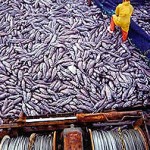 sport, and ecotourism allows Pacific Islanders to earn a living and support their families. Unfortunately, the livelihood of these native peoples is threatened by overfishing and exploitation. Overfishing not only decreases fish availability, but by removing those species feeding on algae and seaweed it allows for an overgrowth which can smother corals and other bottom dwelling organisms. Without certain fish species, Islanders are forced to alter their diet and way of life. Furthermore, sport fishing and ecotourism, and subsequent economy, will collapse. No fish means no fishing and no coral means no snorkeling and diving; an unbalanced ecosystem has devastating effects on the environment of both land and sea.
sport, and ecotourism allows Pacific Islanders to earn a living and support their families. Unfortunately, the livelihood of these native peoples is threatened by overfishing and exploitation. Overfishing not only decreases fish availability, but by removing those species feeding on algae and seaweed it allows for an overgrowth which can smother corals and other bottom dwelling organisms. Without certain fish species, Islanders are forced to alter their diet and way of life. Furthermore, sport fishing and ecotourism, and subsequent economy, will collapse. No fish means no fishing and no coral means no snorkeling and diving; an unbalanced ecosystem has devastating effects on the environment of both land and sea.
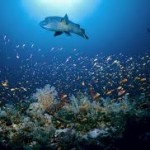 Coral reefs are among the oldest documented ecosystems; an unbelievable diversity of species can only be found among the reefs. Coral reefs are important for subsistence, fisheries, tourism, and act as natural barriers protecting shorelines from
Coral reefs are among the oldest documented ecosystems; an unbelievable diversity of species can only be found among the reefs. Coral reefs are important for subsistence, fisheries, tourism, and act as natural barriers protecting shorelines from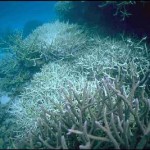 eroding forces of the sea, thereby protecting coastal villages, agricultural land, and beaches. Although coral reefs cover less than 1% of the Earth’s surface, they are home to 25% of all marine fish species. The Ocean Conservancy states, “At least 500 million people rely on coral reefs for food, coastal protection, and livelihoods. It is estimated that coral reefs provide $375 billion US per year around the world in goods and services.”
eroding forces of the sea, thereby protecting coastal villages, agricultural land, and beaches. Although coral reefs cover less than 1% of the Earth’s surface, they are home to 25% of all marine fish species. The Ocean Conservancy states, “At least 500 million people rely on coral reefs for food, coastal protection, and livelihoods. It is estimated that coral reefs provide $375 billion US per year around the world in goods and services.”
The oceans act as great migratory pathways to the largest creatures currently known to man. Whales and sharks traverse the oceans to find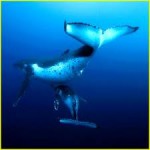 breeding, feeding, and birthing areas required to sustain their populations. Boating trips for a glimpse at the dorsal fins and flukes of whales, dolphins, and sharks generate over $2 billion US annually. Not only is it fascinating to partake in an open ocean voyage, but to appreciate the actual size of such a large being is incomprehensible unless witnessed firsthand. Yet with all the interest we have to see these magnificent creatures, almost 100 million sharks are killed every year; having their fins removed to fuel the every growing demand for shark fin soup. Native people living in coastal areas have relied on the sea for centuries for food, maintaining a sustainable harvesting practice of fish and whales. Japan continues to whale in international waters not to feed a hungry nation, although the meat does end up on supermarket shelves, but as a scientific
breeding, feeding, and birthing areas required to sustain their populations. Boating trips for a glimpse at the dorsal fins and flukes of whales, dolphins, and sharks generate over $2 billion US annually. Not only is it fascinating to partake in an open ocean voyage, but to appreciate the actual size of such a large being is incomprehensible unless witnessed firsthand. Yet with all the interest we have to see these magnificent creatures, almost 100 million sharks are killed every year; having their fins removed to fuel the every growing demand for shark fin soup. Native people living in coastal areas have relied on the sea for centuries for food, maintaining a sustainable harvesting practice of fish and whales. Japan continues to whale in international waters not to feed a hungry nation, although the meat does end up on supermarket shelves, but as a scientific  endeavor. However, to date, no scholarly articles or books have been written explaining the importance of this so called “research.” In addition, dolphin harvesting is still carried out in some Japanese towns bordering the sea annually. Dolphins are herded into harbors to be slaughtered or sold to internationally buyers to be put on display in aquariums or in aquatic shows. If we, as humans, are so awestruck by these creatures that we are spending over $2 billion US annually for a mere glimpse then why aren’t we doing more to save them from imminent extinction?
endeavor. However, to date, no scholarly articles or books have been written explaining the importance of this so called “research.” In addition, dolphin harvesting is still carried out in some Japanese towns bordering the sea annually. Dolphins are herded into harbors to be slaughtered or sold to internationally buyers to be put on display in aquariums or in aquatic shows. If we, as humans, are so awestruck by these creatures that we are spending over $2 billion US annually for a mere glimpse then why aren’t we doing more to save them from imminent extinction?
Sadly, our oceans are getting trashier by the day. Currently, there are five patches of floating garbage in our oceans; the Great Pacific Garbage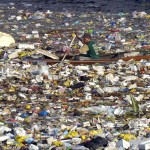 Patch alone is the size of the US state of Texas. For years offshore dumping of human generated trash including medical and biological waste, hazardous, even radioactive, chemicals and household garbage have contaminated the very water we rely on for life. Furthermore, chemicals that are used on land i.e., pesticides, insecticides, fungicides, and herbicides find their way into local watershed destined for the ocean, poisoning our seas and all inhabitants. Fish, marine mammals, birds, aquatic
Patch alone is the size of the US state of Texas. For years offshore dumping of human generated trash including medical and biological waste, hazardous, even radioactive, chemicals and household garbage have contaminated the very water we rely on for life. Furthermore, chemicals that are used on land i.e., pesticides, insecticides, fungicides, and herbicides find their way into local watershed destined for the ocean, poisoning our seas and all inhabitants. Fish, marine mammals, birds, aquatic  plants, marine invertebrates, ocean dwelling reptiles, mollusks like cephalopods, and coral reefs are all at risk by the waste products we carelessly discard. Plastics can choke and tangle species causing death by drowning or asphyxiation. Oil spills destroy marine habitat from the surface to the sea floor, and continue to have devastating consequences to life for decades after the initial assault. Why are we not more careful? Is this a case of out of sight, out of mind?
plants, marine invertebrates, ocean dwelling reptiles, mollusks like cephalopods, and coral reefs are all at risk by the waste products we carelessly discard. Plastics can choke and tangle species causing death by drowning or asphyxiation. Oil spills destroy marine habitat from the surface to the sea floor, and continue to have devastating consequences to life for decades after the initial assault. Why are we not more careful? Is this a case of out of sight, out of mind?
Climate change continues to alter the ocean habitat. Increasing ocean temperatures have caused polar ice to melt at an alarming rate. As the temperatures rise, marine life is forced to adapt or die. Much debate surrounds those causative factors albeit by a natural progressing weather  pattern or anthropogenic. Regardless, I think we can all agree that the climate is changing and as a consequence animals and humans are changing too. Polar bears rely on ice to hunt; they have an incredible talent for finding seals hiding up to 3 m (9 ft) below the surface of the ice. In addition, polar bears are accomplished swimmers and able to hunt at sea in open water and by utilizing ice floats. With shrinking ice comes shrinking habitat for polar bears to hunt. There has been an increase in the sightings of dead polar bears caused by starvation and drowning in the last 10 years. A side note is that these documented observations remain very controversial among scientists and government officials. Consequently, those bears that have survived have done so my traveling outside their natural home range and into unfamiliar territory. Inhabiting new areas puts pressure on additional ecosystems that are now forced to sustain a large, non-native carnivore. Moreover, incidences of polar bear-human conflicts have increased, as well as hybrid breeding with grizzly bears. Keep in mind this is just the story of a single species; the butterfly effect certainly stands true. Imagine those problems effecting other species that are yet to be seen.
pattern or anthropogenic. Regardless, I think we can all agree that the climate is changing and as a consequence animals and humans are changing too. Polar bears rely on ice to hunt; they have an incredible talent for finding seals hiding up to 3 m (9 ft) below the surface of the ice. In addition, polar bears are accomplished swimmers and able to hunt at sea in open water and by utilizing ice floats. With shrinking ice comes shrinking habitat for polar bears to hunt. There has been an increase in the sightings of dead polar bears caused by starvation and drowning in the last 10 years. A side note is that these documented observations remain very controversial among scientists and government officials. Consequently, those bears that have survived have done so my traveling outside their natural home range and into unfamiliar territory. Inhabiting new areas puts pressure on additional ecosystems that are now forced to sustain a large, non-native carnivore. Moreover, incidences of polar bear-human conflicts have increased, as well as hybrid breeding with grizzly bears. Keep in mind this is just the story of a single species; the butterfly effect certainly stands true. Imagine those problems effecting other species that are yet to be seen.
 Without the ocean, life is not possible. Though we should do all that we can to ensure our oceans are conserved and maintained in a pristine state, we treat it as though we have a spare. We can no longer look at the ocean as a great blue abyss that has an unlimited supply of aquatic life and space. Whether we are aware of it or not, humans are masters of our own fate. As we live our everyday lives we must be made aware that the resources we use can have devastating effects on our environment, specifically our oceans. From the discarded cup we drink our morning coffee out of, water bottle we throw away from lunch, energy we use in our homes, plastic bags to carry our groceries, gas used in our cars
Without the ocean, life is not possible. Though we should do all that we can to ensure our oceans are conserved and maintained in a pristine state, we treat it as though we have a spare. We can no longer look at the ocean as a great blue abyss that has an unlimited supply of aquatic life and space. Whether we are aware of it or not, humans are masters of our own fate. As we live our everyday lives we must be made aware that the resources we use can have devastating effects on our environment, specifically our oceans. From the discarded cup we drink our morning coffee out of, water bottle we throw away from lunch, energy we use in our homes, plastic bags to carry our groceries, gas used in our cars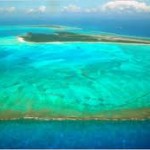 to drive to work, and food we choose to eat, our every move has a consequence. You would be surprised the impact we can all make by changing one simple thing. While perusing the internet, check out a website on ocean conservation. Educate yourselves and educate others on what fish is taken from the seas in unsustainable quantities and what species are better alternatives for consumption. Practice the 3R philosophy to conservation: reduce, reuse, recycle. To quote Jean Michel Cousteau, “Our perceptions of the ocean have to evolve.”
to drive to work, and food we choose to eat, our every move has a consequence. You would be surprised the impact we can all make by changing one simple thing. While perusing the internet, check out a website on ocean conservation. Educate yourselves and educate others on what fish is taken from the seas in unsustainable quantities and what species are better alternatives for consumption. Practice the 3R philosophy to conservation: reduce, reuse, recycle. To quote Jean Michel Cousteau, “Our perceptions of the ocean have to evolve.”
